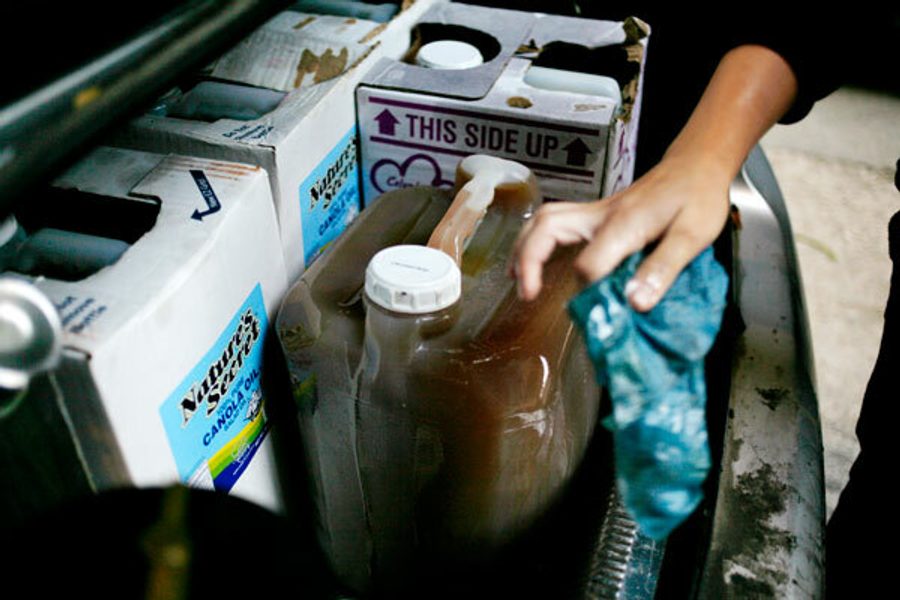Grease Guzzlers
Why diesel engines and vegetable oil should become best friends.
Zachary Gonzalez-Landis

As frugal consumers demand more from their vehicles, and bailed-out car companies scramble to manufacture affordable yet eco-friendly models, some drivers are turning to an alternative to the gas-guzzling status quo: vegetable oil.
Vegetable oils are biofuels, renewable raw materials from which one can extract the same kind of energy as found in fossil fuels, such as natural gas and coal. For far less than the price of a new car, diesel engines can be converted to run entirely on straight vegetable oil (SVO). Or, when combined with an alcohol and a catalyst (such as sodium hydroxide), any blend of vegetable oil – peanut, canola, soybean, etc. – transforms into biodiesel, a substitute for diesel fuel that requires no additional vehicle modifications. Just pour in the treated veggie oil and start the engine.
The benefits of using biodiesel rattle off like the agenda for this year’s Climate Conference in Copenhagen: it’s a recycled resource; reduces air pollution and greenhouse gases; biodegrades and is non-toxic; decreases dependence on imported oil; and offers better fuel economy than diesel. Overall, biodiesel presents the lowest carbon footprint of any alternative fuel. And it’s cheaper.
Chicago Biofuels trumpeted these benefits at its Annual Veggie Car Show in September, an event that brought together biofuel users, educators and advocates from around the Midwest. Now in its third year, the car show featured 12 fully functional diesel vehicles running on either biodiesel or SVO, with some owners even blending their own fuel at home.
Formed in 2007, the volunteer-run group commits itself to instructing both the public and private sectors regarding the environmental and economic advantages of alternative fuels. They actively collect donated waste oil from six Chicago-area restaurants for biodiesel conversion and develop renewable energy curriculum for use in high schools.
“Basically, we decided to get together and try to push renewable fuel options,” says Pete Probst, one of the organization’s co-founders and the driver of an SVO-converted 1979 Mercedes Benz. “That all starts with education and awareness. And you can do biofuel immediately.”
He does note, however, that biodiesel represents only a portion of the needed action to combat climate change. “It’s a niche market. We’re just not selling diesel cars in America. If there was a carbon cap and trade, that would drive up the demand for biodiesel. But first we need policy change.”
Probst estimates less than five percent of all cars on U.S. roads run on diesel, despite the fact that diesel engines are about 30 percent more efficient than gasoline engines. Compare that number to Europe, where diesel comprises over 40 percent of all passenger vehicles, and it’s easy to guess which side of the Atlantic encourages more biodiesel distribution.
Not to say the U.S. government turns a blind eye to biofuel options. According to a report filed by the Global Subsidies Initiative (GSI), a research collaborative dedicated to monitoring government subsidies worldwide, U.S. biodiesel subsidies for both production and consumption exceeded $1.5 billion in 2008, with projected subsidies to measure over $10 billion by 2012. However, those figures pale in comparison to the more controversial ethanol, the recipient of more than $9 billion in subsidies for 2008 and an estimated total of $82 billion between 2006-2012.
Even with such disparity in government support, these subsidies nonetheless encouraged the U.S. biodiesel industry to grow far beyond demand, creating a glut in the market and industry-wide contraction. In 2007, GSI estimated the industry’s utilization capacity at about 50 percent. In August 2009, The Wall Street Journal reported that about two-thirds of U.S. biodiesel production is unused.
Indeed, the number one sales outlet for the U.S. biodiesel industry is actually Europe – American companies comprised 17 percent of the European Union (EU) market in 2008.
That statistic turned rather dubious last July when highlighted by the EU as the primary reason for imposing a five-year tariff on U.S. biodiesel, effectively nullifying any export affordability. Factor in the recession, lower crude oil prices, and a public largely unaware of biodiesel in the first place, and many count the EU’s recent legislation as more than just a serious blow to the industry.
But at the local level, biofuel users remain unfazed. Brian Fragassi, a building inspector from Huntley, Illinois, converted his 2002 Ford F250 to run on SVO in 2007. “First few months, you’re on needles and pins, and years later you’re still amazed that it works.”

I hope you found this article important. Before you leave, I want to ask you to consider supporting our work with a donation. In These Times needs readers like you to help sustain our mission. We don’t depend on—or want—corporate advertising or deep-pocketed billionaires to fund our journalism. We’re supported by you, the reader, so we can focus on covering the issues that matter most to the progressive movement without fear or compromise.
Our work isn’t hidden behind a paywall because of people like you who support our journalism. We want to keep it that way. If you value the work we do and the movements we cover, please consider donating to In These Times.




